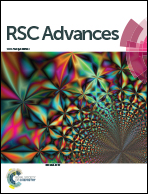Facile synthesis of a CNT@Fe@SiO2 ternary composite with enhanced microwave absorption performance
Abstract
Magnetic/dielectric core–shell structures have been regarded as ideal high-performance electromagnetic absorption materials due to their novel multiple-loss mechanism. However, the poor impedance matching property of a dielectric shell may lead to the high reflection of electromagnetic waves from the interface of the shell. Thus, we ingeniously use the magnetic material as the shell while the dielectric material is used as the core. Such a change not only decreases the electromagnetic wave reflection, but also causes a strong interface polarization. Subsequently, the wave-transparent material SiO2 was further coated on the surface of the magnetic shell which not only protected it from oxidation but also increased the impedance matching performance. Based on the above design, in this study, we fabricated a CNT@Fe@SiO2 ternary core–shell structure composite using a simple two-step approach consisting of pyrolysis and decomposition processes. As compared with pure CNTs and CNT@Fe materials, the obtained CNT@Fe@SiO2 composite shows obviously enhanced electromagnetic absorption properties. In particular at a thin thickness of 1.5 mm, the optimal reflection loss value is as high as −14.2 dB which is better than most of the reported CNT based absorbers. The improved electromagnetic absorption properties can be attributed to the perfect impedance matching behavior and the multiple interface polarization effect.


 Please wait while we load your content...
Please wait while we load your content...